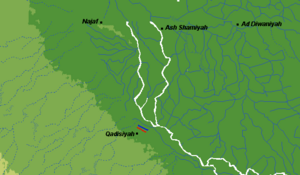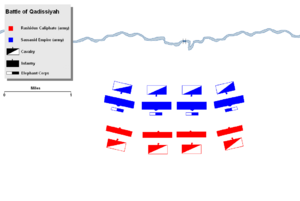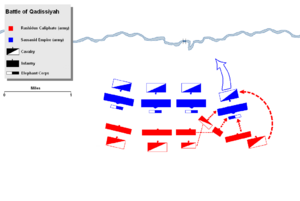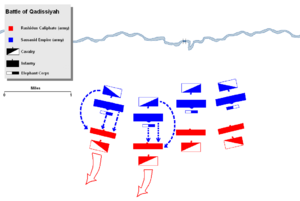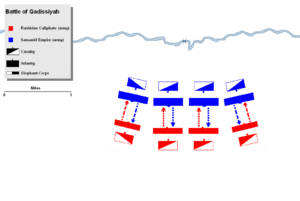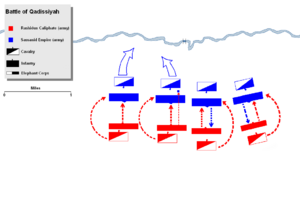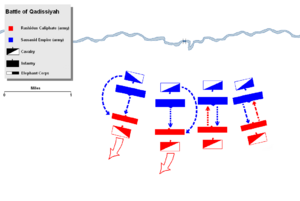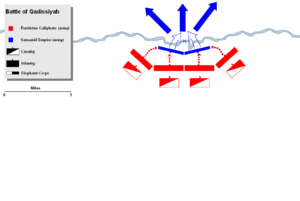Battle of al-Qadisiyyah facts for kids
Quick facts for kids Battle of al-Qādisiyyah |
|||||||||
|---|---|---|---|---|---|---|---|---|---|
| Part of the Muslim conquest of Persia | |||||||||
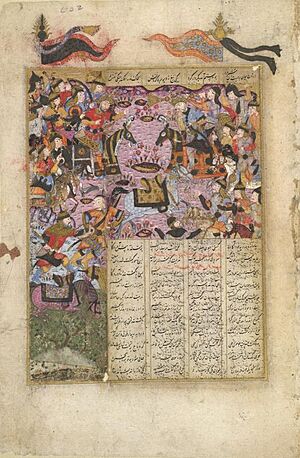 A picture of the battle from an old Persian storybook called Shahnameh |
|||||||||
|
|||||||||
| Belligerents | |||||||||
| Rashidun Caliphate | |||||||||
| Commanders and leaders | |||||||||
| Sa`d ibn Abī Waqqās Khalid bin Arfatah Al-Muthanna ibn Haritha Al-Qa'qa' ibn Amr al-Tamimi Asim ibn 'Amr al-Tamimi Abdullah ibn al-Mu'tam Shurahbil ibn Simt Zuhra ibn al-Hawiyya Jarir ibn Abd Allah al-Bajali Tulayha Amru bin Ma'adi Yakrib |
|||||||||
| Units involved | |||||||||
| Rashidun army | Sasanian army | ||||||||
| Strength | |||||||||
| 30,000–40,000 | 30,000-40,000(medieval estimate) | ||||||||
| Casualties and losses | |||||||||
| Heavy | Heavy | ||||||||
The Battle of al-Qadisiyyah was a huge fight that happened in 636 CE. It was between the Rashidun Caliphate (an early Islamic empire) and the Sasanian Empire (a powerful Persian empire). This battle was a big part of the early Muslim conquests and a major win for the Rashidun army during the Muslim conquest of Persia.
The battle took place in November 636 near a town called Qadisiyyah. The Sasanian army's leader, Rostam Farrokhzad, died during the fight. After this, the Sasanian army in the area fell apart. This led to a clear victory for the Arabs and helped them take control of the land that is now Iraq.
Winning at Qadisiyyah was very important for the Muslims. It helped them conquer more Sasanian lands later. Some stories say that the Sasanian Empire and the Byzantine Empire even teamed up against the Muslims. The Byzantine emperor Heraclius supposedly married his granddaughter to the Sasanian king Yazdegerd III to show their alliance.
Contents
Why Did the Battle Happen?
Empires at War: Byzantines and Sasanians
Before the Battle of Qadisiyyah, two huge empires, the Byzantine Empire and the Sasanian Empire, were often fighting. A long war, called the Byzantine–Sasanian War of 602–628, had just ended. The Sasanians had taken over lands like Syria and Egypt.
Later, the Byzantine emperor Heraclius fought back and won. He got back the lost lands. The Sasanian king, Khosrow II, was overthrown and killed by his own son, Kavadh II. Kavadh II then made peace with the Byzantines.
Who Would Rule Next?
After a few months, Kavadh II died from a disease. This caused a lot of confusion and fighting over who would be the next ruler in the Sasanian Empire. Many different people tried to become king or queen.
One of them was Boran, a daughter of Khosrow II. She tried to bring peace and order back to the empire. She lowered taxes and made a peace treaty with the Byzantines. But the empire was still weak from all the civil wars.
Finally, after five years of struggles, Yazdegerd III became emperor in 632. He was only eight years old. The real power was held by strong generals like Rostam Farrokhzād. Yazdegerd III's rule gave new hope to the Sasanian Empire.
The Rise of the Caliphate
Around this time, the Rashidun Caliphate was growing quickly in Arabia. After the death of Muhammad, the first leader, Abu Bakr, united Arabia. Then, he started sending armies to conquer new lands.
These new Islamic armies soon met the powerful Byzantine and Sasanian empires. The goal was to expand the new Islamic empire. A skilled general named Khalid ibn al-Walid led the early Muslim armies. He won many quick battles in Iraq, like the Battle of Chains and the Battle of Walaja.
By 633, Khalid had captured most of Iraq, except for the Sasanian capital, Ctesiphon. But then, Khalid and half his army were sent to fight the Byzantines in Syria.
After Abu Bakr died, Umar ibn al-Khattāb became the new Caliph. The Muslim forces in Iraq were now much smaller. The Persians, after their earlier defeats, started to fight back. The Muslim commander, Al-Muthanna ibn Haritha, had to pull his troops back.
Umar sent more soldiers from Madinah to Iraq. The Muslims won some battles and recaptured some areas. But then, they suffered a big loss at the Battle of the Bridge, where their commander Abu Ubaid was killed. Muthanna took command and retreated again.
Persian Counterattack Plans
After Khalid left Iraq, the area between the Euphrates and Tigris rivers was still unstable. The Persians and Muslims kept fighting over it. Emperor Yazdegerd III then made a deal with the Byzantine emperor Heraclius in 635. They planned a huge attack together to crush the Muslims. Heraclius even married his granddaughter to Yazdegerd III to seal their alliance.
Heraclius launched his attack in May 636. But Yazdegerd couldn't get his army ready in time, so their plan didn't work out as they hoped. Caliph Umar knew about this alliance. He decided to defeat the Byzantines first, then deal with the Persians.
Umar sent 6,000 extra soldiers to his army fighting the Byzantines at the Battle of Yarmouk. This battle happened in August 636, three months before Qadisiyyah. The Byzantines were completely defeated. This meant the Roman Emperor's attack in the west was over.
Even though his ally lost, Yazdegerd still wanted to attack. He gathered a huge army near his capital, Ctesiphon. This large force was led by the experienced general Rostam. Umar told Muthanna to pull back from Iraq to the edge of the Arabian Desert. The fight for Iraq would happen later.
How Muslims Prepared for Battle
Caliph Umar started gathering new armies from all over Arabia to invade Iraq again. He chose Sa'd ibn Abī Waqqās to lead this army. Sa'd was an important member of the Quraysh tribe.
In May 636, Sa'd was told to march to Northern Arabia with 4,000 men. He would then take command of the Muslim army and head to Iraq. Sa'd was new to being a general, so Umar told him to get advice from experienced commanders. Umar ordered him to stop at al-Qadisiyyah, a small town near Kufah.
Umar kept giving orders and advice to his army from far away. Because they needed more soldiers, Umar allowed tribes who had once rebelled to join the army. This army was made of volunteers from all over Arabia.
After the big win against the Byzantines at Yarmouk, Umar sent veteran soldiers from that battle to Iraq. About 5,000 experienced fighters arrived at Qadisiyyah on the second day of the battle. This really boosted the Muslim army's spirits and helped them a lot.
The Battlefield
Qadisiyyah was a small town by the Ateeq river, which was a branch of the Euphrates river. The old capital of the Lakhmid Dynasty, Al-Hira, was about thirty miles to the west. Today, Qadisiyyah is in the southwest of al-Hillah and Kufah in Iraq.
How the Armies Lined Up
Experts today think both the Sasanian and Muslim armies had about 30,000 to 40,000 soldiers. The Muslim army grew to 36,000 after more soldiers arrived from Syria. Most historians agree that the Sasanian army and their allies were much larger than the Muslim Arabs.
Sasanian Persia's Army
The Persian army arrived at Qadisiyyah in July 636. They set up strong camps on the east side of the Ateeq river. There was a bridge over the river, which was the only way to their main camps. They also had boats ready.
The Sasanian Persian army had about 60,000 soldiers. They had three main types of fighters: infantry (foot soldiers), heavy cavalry (soldiers on horses with strong armor), and the Elephant corps. The elephants were trained in India.
On November 16, 636, the Sasanian army crossed to the west side of the Ateeq river. Rostam lined up his 45,000 foot soldiers in four groups, each about 150 meters apart. He kept 15,000 cavalry soldiers in reserve for counter-attacks. There were about 33 elephants, with eight in each of the four army groups. The battle line was about 4 kilometers long.
Rostam watched the battle from a high spot, under a canopy, near the river. The famous Derafsh-e-Kāveyān (the 'flag of Kāveh'), the Sasanian flag, waved beside him. Rostam had men placed along the way to the capital, Ctesiphon, to send news quickly.
Rashidun (Muslim) Army
In July 636, the main Muslim army marched to Qadisiyyah. After setting up camp and defenses, Sa'd sent groups to raid nearby areas. Sa'd kept in touch with Caliph Umar, sending him detailed reports about the land.
The Muslim army had about 30,000 soldiers, including 7,000 cavalry. This number grew to 36,000 with soldiers from Syria and local Arab allies. Sa'd had a health problem, so he directed the battle from an old palace in Qadisiyyah. He could see the battlefield well from there. He appointed Khalid ibn Urfuta as his helper, who carried out his orders to the battlefield.
The Muslim foot soldiers were in four groups, each with its own cavalry behind for counter-attacks. Each group was about 150 meters apart. The army was organized by tribes and clans. This meant everyone fought next to people they knew, and tribes were responsible for their soldiers.
Weapons Used
Muslim soldiers wore helmets, some like the Sasanian silver helmets. They often used chain mail to protect their faces and necks. They also wore heavy leather sandals or Roman-style boots. Their armor included tough leather scales or lamellar armour and mail. Foot soldiers had more armor than cavalry. They used Hauberks (chain mail shirts) and large wooden or wickerwork shields.
Spears were common. Foot soldiers used spears about 2.5 meters long, while cavalry used longer ones, up to 5.5 meters. Swords were like the Roman gladius or the Sasanian long sword. Both were hung from a baldric (a shoulder strap). Bows were about two meters long when unstrung and could shoot arrows up to 150 meters. Muslim archers were very good at fighting enemy cavalry. Muslim troops fighting the Sasanians had lighter armor compared to those fighting the Byzantines.
The Battle Begins
The Muslim army had been camped at al-Qadisiyyah since July 636. Caliph Umar told Sa'd to send messengers to Yazdegerd III and General Rostam. The messengers invited them to become Muslims. For three months, the Arabs and Persians talked.
One Muslim messenger, An-Numan ibn Muqarrin, went to Ctesiphon to meet Emperor Yazdgerd III. He asked the Sasanian emperor to become Muslim or agree to pay a special tax called jizyah. But the mission failed.
During one meeting, Yazdgerd III tried to embarrass the Arabs. He ordered his servants to put a basket of earth on the head of Asim ibn 'Amr al-Tamimi, a Muslim messenger. But the clever Arab messenger saw this as a good sign. He said, "Congratulations! The enemy has given us their land!" (meaning the earth in the basket). Rostam, the Persian general, agreed with Asim. He supposedly told Yazdgerd III off for the basket of earth, saying it meant the Persians had given their land to the Muslims. Yazdgerd III then ordered soldiers to chase the messengers and get the basket back, but they were already gone.
When things calmed down on the Syrian front, Caliph Umar told Sa'd to stop talking. This was a clear sign for the Persians to get ready for battle. Rostam, who was at Valashabad, moved his camp to Qadisiyyah. He still wanted to avoid fighting and tried to talk peace again. Sa'd sent Rabi bin Amir and later Mughirah bin Zurarah to talk.
Rostam tried to convince the Arabs to leave peacefully. He said, "You are neighbors. We have been kind to you, protected you, and helped you. You grazed your animals in our lands. We gave you food and let you trade. When your land had a drought, we sent you dates and barley. I know you are here because you are poor. I will give your commander clothes and a horse with 1,000 dirhams, and each of you will get dates and two sets of clothes. Please leave our land, because I don't want to capture or kill you."
But the Muslim messengers insisted that the Persians had to choose: become Muslim, pay Jizyah, or fight. Since they couldn't agree, both sides got ready for battle.
Day 1: The Day of Disorder
On November 16, 636, the Persians filled in a canal to make a road. Before dawn, their whole army crossed it. Rostam put on two sets of armor and got his weapons ready. The two armies stood about 500 meters apart. The Muslim army faced northeast, and the Sasanian army faced southwest, with the river behind them.
Before the battle, Sa'd encouraged his soldiers. He said, "This is your inheritance, promised by your God. He gave it to you three years ago, and you've been gaining from it, capturing, ransoming, and killing its people." Asim ibn 'Amr told the riders, "You are better than them, and God is with you. If you keep fighting and strike well, their riches, women, and children will be yours."
The battle started with one-on-one duels. Muslim champions, called Mubarizun, stepped forward. Many fell on both sides. Muslim stories tell of brave duels between Sasanian and Muslim heroes. These duels were meant to lower the enemy's morale by killing their best fighters.
After losing several duels, Rostam ordered his left wing to attack the Muslim right wing. The Persian attack began with many arrows, hurting the Muslim right wing. Elephants led the charge for the Persians. Abdullah ibn Al-Mutim, the Muslim commander of the right wing, told Jareer ibn Abdullah (his cavalry commander) to deal with the elephants. But Jareer's cavalry was stopped by the Sasanian heavy cavalry. The elephants kept moving forward, and the Muslim foot soldiers started to fall back.
Sa'd sent orders to Al-Ash'ath ibn Qays, commander of the center-right cavalry, to stop the Sasanian cavalry. Al-Ash'ath led a cavalry group that helped the right wing and attacked the side of the Sasanian left wing. Meanwhile, Sa'd told Zuhra ibn Al-Hawiyya, commander of the Muslim right center, to send foot soldiers to help the right wing. A group of foot soldiers under Hammal ibn Malik helped the right wing fight back against the Sasanians. The Sasanian left wing retreated because of the Muslim foot soldiers' attack from the front and the Muslim cavalry's attack from the side.
With his first attacks pushed back, Rostam ordered his right center and right wing to attack the Muslim cavalry. The Muslim left wing and left center were first hit by many arrows. Then, the Sasanian right wing and right center charged. Again, the Elephant corps led the charge. The Muslim cavalry on the left wing and left center panicked because of the elephants. They were pushed back by the combined attack of the Sasanian heavy cavalry and elephants.
Sa'd told Asim ibn 'Amr, commander of the left center, to defeat the elephants. Asim's plan was to kill the archers on the elephants and cut the straps holding the saddles. Asim ordered his archers to shoot the men on the elephants and his foot soldiers to cut the saddle straps. This plan worked. As the Persians pulled back the elephants, the Muslims attacked. The Sasanian army's center-right retreated, and then their whole right wing retreated.
By afternoon, the Persian attacks on the Muslim left wing and left center were also pushed back. Sa'd, wanting to use this chance, ordered another attack. The Muslim cavalry charged from the sides with full force. This tactic was called Karr wa farr. Rostam eventually pushed back the Muslim attacks. He even joined the fight himself and was said to have been wounded several times. The fighting stopped at dusk. The first day was not a clear win for either side, and both had many losses.
In Muslim stories, the first day of the Battle of Qadisiyyah is called Yawm al-Armath, meaning "The Day of Disorder."
Day 2: Reinforcements Arrive
On November 17, Sa'd decided to start the day with duels again to hurt the Persians' morale. At noon, while the duels were still happening, more Muslim soldiers arrived from Syria. First, an advance group led by Al-Qaqa ibn Amr al-Tamimi arrived. Then, the main army came, led by Hashim ibn Utbah, Sa'd's nephew.
Qa’qa split his advance group into smaller teams. He told them to arrive on the battlefield one after another. This made it look like a huge number of new soldiers were coming. This trick really lowered the Persian army's spirits.
On this day, Qa’qa is said to have killed the Persian general Bahman, who had led the Sasanian army at the Battle of Bridge. Since there were no elephants in the Sasanian army that day, Sa'd wanted to use this chance to break through. He ordered a general attack. All four Muslim groups charged forward. But the Sasanians stood strong and pushed back the attacks.
During these charges, Qa’qa used a clever trick. He made camels look like strange monsters. These "monsters" moved toward the Sasanian front. When the Sasanian horses saw them, they got scared and ran away. This made the Sasanian cavalry disorganized and left their foot soldiers in the center vulnerable.
Sa'd told the Muslims to attack harder. Qa’qa ibn Amr, now leading the Muslim army on the field, planned to kill Rostam. He led a group of champions from his Syrian soldiers, who had also fought in the Battle of Yarmouk. They pushed through the Sasanian right center toward Rostam's command post. Rostam again personally led a counterattack against the Muslims, but he couldn't break through. At dusk, both armies went back to their camps.
Day 3: The Night of Rumbling Noises
On November 18, Rostam wanted to win quickly before more Muslim soldiers arrived. The Elephant corps was back in front of the Sasanian army, giving them an advantage. Rostam used this advantage and ordered a general attack along the entire Muslim front. All four Sasanian groups moved forward and hit the Muslims.
The Persian attack started with many arrows and other flying objects. The Muslims suffered heavy losses before their archers shot back. The Persian elephant corps again led the charge, supported by their foot soldiers and cavalry. When the Sasanian elephants came close, the Muslim riders again became scared, causing confusion in the Muslim lines. The Sasanians pushed their attack, and the Muslims fell back.
Through the gaps in the enemy's lines caused by the Sasanian advance, Rostam sent a cavalry group to capture the old palace where Sa'ad was. Rostam's plan was to kill or capture the Muslim Commander-in-Chief to lower the Muslims' morale. However, a strong group of Muslim cavalry quickly came and drove away the Sasanian cavalry.
Sa'd realized there was only one way to win: destroy the Sasanian elephant corps, which was causing so much trouble for the Muslims. After a long fight, the Muslims finally succeeded. The scared elephants ran through the Sasanian lines and headed for the river. By noon, there were no elephants left on the battlefield. The elephants running away caused a lot of confusion in the Sasanian ranks.
To use this situation even more, Sa'd ordered a general attack, and the two armies clashed again. Even with the Muslims' repeated charges, the Sasanians held their ground. Without the Persian elephants, the Muslims again brought up camels disguised as monsters. But this trick didn't work this time, and the Persian horses stayed put.
The third day of the battle was the hardest for both armies. Many soldiers were killed on both sides. Even though they were tired after three days of fighting, the armies kept going. The fight lasted all night and ended at dawn. It became a test of who could last longer, with both sides almost giving up. Sa'd's plan was to wear down the Persians and win. In Muslim stories, the third day is called Yaum-ul-Amas, and the night is called Lailat-ul-Harir, meaning the "Night of Rumbling Noises."
Day 4: The Final Push
At sunrise on November 19, 636, the fighting had stopped, but the battle was still not decided. Qa'qa, with Sa'd's approval, was now leading the Muslim troops on the field. He is said to have told his men:
"If we fight for an hour or so more, the enemy will be defeated. So, warriors of Bani Tameem make one more attempt and victory will be yours."
The Muslim left center, led by Qa’qa, charged forward and attacked the Sasanian right center. Then, all the Muslim groups attacked. The Sasanians were surprised that the battle started again. The Sasanian left wing and left center were pushed back. Qa’qa again led a group of champions against the Sasanian left center. By noon, he and his men were able to break through the Sasanian center. However, they couldn't completely break the Persian army.
Rostam's Death and Persian Defeat
On the last day, Rostam was killed, which led to the Persians' defeat. There are different stories about how he died:
1) Qa'qa and his men rushed toward the Sasanian headquarters. During a sandstorm, Rostam was found dead with more than five wounds on his body. The Persians didn't know he was dead and kept fighting. The Sasanian right wing attacked back and got their lost position back. The Muslim left wing also went back to its original spot. The Muslim left center, under Qa’qa's command, also retreated because their left wing didn't support them. Sa'd then ordered a general attack on the Sasanian front to drive away the Persians, who were losing hope because their leader was dead. In the afternoon, the Muslims attacked again.
2) Another story says there was a heavy sandstorm facing the Persian army. Rostam lay next to a camel to hide from the storm. Weapons like axes and swords were loaded on the camel. Hilāl ibn 'Ullafah accidentally cut the rope holding the load on the camel, not knowing Rostam was behind it. The weapons fell on Rostam and broke his back, leaving him badly hurt. Hilal then cut off Rostam's head and shouted, "I swear by the god of Kaaba that I have killed Rostam!" The Persians lost hope, and their commanders lost control of the army. Many Persian soldiers were killed in the chaos, many escaped across the river, and the rest of the army surrendered. This story is thought to be unlikely by many historians.
The Sasanian front, after a final stand, finally broke apart. Part of the Sasanian army retreated in an organized way, while the rest ran in panic toward the river. At this point, Jalinus took command of what was left of the Sasanian army. He managed to control the bridgehead and get most of the army safely across the bridge. The Battle of al-Qadisiyyah was over, and the Muslims had won. Sa'd sent cavalry groups in different directions to chase the fleeing Persians. Any Persians they found were either killed or captured. The Sasanians suffered many losses during these chases.
What Happened Next?
After this battle, the Arab Muslims gained a lot of valuable items. This included the famous royal flag, decorated with jewels, called the Derafsh-e-Kāveyān. The jewels were cut up and sold in pieces in Medina. The Arab fighters from this battle became known as 'Ahl al-Qādisiyyah' (people of Qadisiyyah). They were highly respected among later Arab settlers in Iraq.
Once the battle was over, Sa'd sent a report of the Muslim victory to Umar. The battle greatly weakened Sasanian rule in Iraq. But it wasn't the end of their control there. As long as the Sasanians held their capital, Ctesiphon, there was a chance they would try to get back what they lost.
So, Caliph Umar told Sa'd to push forward and capture Ctesiphon. The Siege of Ctesiphon lasted two months, and the city was finally taken in March 637. Muslim forces then conquered Persian areas up to Khuzistan.
However, the conquest slowed down because of a bad drought in Arabia in 638 and a disease called the plague in southern Iraq and Syria in 639. After this, Caliph Umar wanted a break to manage the lands they had conquered. He wanted to leave the rest of Persia alone for a while. Umar is said to have wished for "a mountain of fire between us and the Persians, so that neither they could get to us, nor we to them."
The Persians, however, felt very embarrassed and angry. Their pride was hurt by the Arabs conquering Iraq. So, the Sasanians kept fighting to get their lost land back. A major Persian counterattack was launched and defeated at the Battle of Nahavand in December 641.
After that, Umar planned a full invasion of the Sasanian Empire to conquer it completely. The last Persian emperor was Yazdgerd III, who was killed in 651. His death officially marked the end of the Sasanian royal family and empire.
Images for kids



